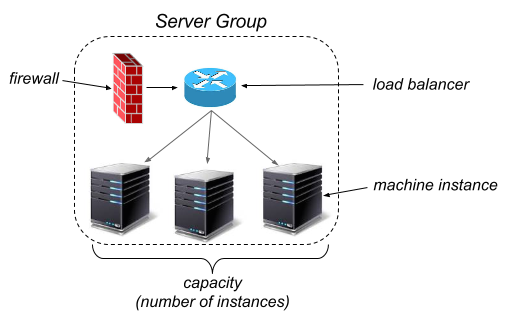Spinnaker is an open source, multi-cloud continuous delivery platform for releasing software changes with high velocity and confidence.
It provides two core sets of features: cluster management and deployment management. Below we give a top-level overview of these features.
Spinnaker's cluster management features are used to manage resources in the cloud.
- Server Group: The base resource to be managed is the Server Group. A Server Group identifies the machine instance profile on which to execute images along with the number of instances, and is associated with a Load Balancer and a Security Group. A Server Group is also identified with basic configuration settings, such as user account information and the region/zone in which images are deployed. When deployed, a Server Group is a collection of virtual machines running software.
- Security Group: A Security Group defines network traffic access. It is effectively a set of firewall rules defined by an IP range (CIDR) along with a communication protocol (e.g., TCP) and port range.
- Load Balancer: A Load Balancer is associated with an ingress protocol and port range, and balances traffic among instances in the corresponding Server Group. Optionally, you can enable health checks for a load balancer, with flexiblity to define health criteria and specify the health check endpoint.
- Cluster: A Cluster is a user-defined, logical grouping of Server Groups in Spinnaker.
Spinnaker's deployment management features are used to construct and manage continuous delivery workflows.
- Pipeline: Pipelines are the key deployment management construct in Spinnaker. They are defined by a sequence of stages, along with automated triggers (optional) that kick off the pipeline, parameters that get passed to all stages in the pipeline, and can be configured to issue notifications as the pipeline executes.
Automatic triggers can be a Jenkins job, a CRON schedule, or another pipeline. You can also manually start a pipeline. Notifications can be sent out to email, SMS or HipChat on pipeline start/complete/fail.
- Stage: A Stage in Spinnaker is an atomic building block for a pipeline. Stages in a Pipeline can be sequenced in any order, though some stage sequences may be more common than others. Spinnaker comes pre-packaged with a number of stages, including:
- Bake: Bakes an image in the specified region.
- Deploy: Deploys a previously baked or found image.
- Destroy Server Group: Destroys a server group.
- Disable Server Group: Disables a server group.
- Enable Server Group: Enables a server group.
- Find Image: Finds a previously-baked image to deploy into an existing cluster.
- Jenkins: Runs a Jenkins job.
- Manual Judgment: Waits for user approval before continuing.
- Modify Scaling Process: Suspend or resume server group scaling processes.
- Pipeline: Runs a pipeline. This allows pipelines to be composed hierarchically.
- Quick Patch Server Group: Quick patches a server group. Used for emergency patches.
- Resize Server Group: Resizes a server group.
- Script: Runs an arbitrary shell script.
- Shrink Cluster: Shrinks a cluster.
- Wait: Waits a specified period of time.

